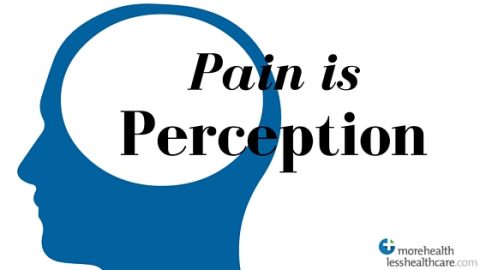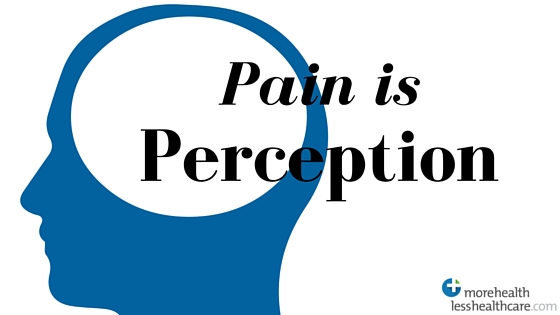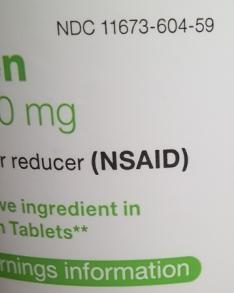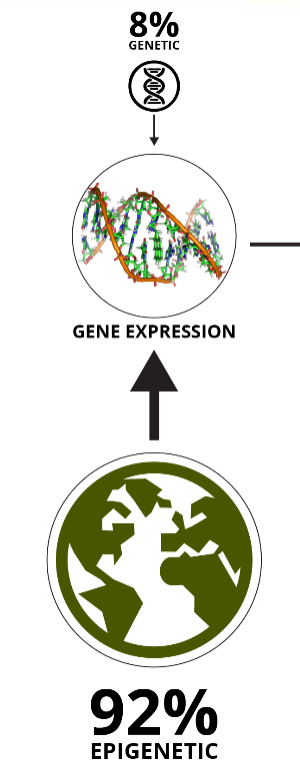
Pain is nothing but a perception.
Pain is the cortical, emotional response to nociceptive information that reaches the cortex and there can be a great deal of nociceptive input that does not reach the conscious brain (cortex). Nociception is the detection of noxious stimuli or stressors and the body responds accordingly by increasing the stress response and associated stress hormones, such as catecholamines (epinephrine/norepinephrine) and cortisol. Increased nociception can lead to sensitization of the nociceptive pathways both peripherally and centrally via the process of synaptogenesis and neuroplasticity. This sensitization process results in lowered firing thresholds and has been documented to lead to allodynia. Dr. James Chestnut
What the flip does all that mean?
Cortical/Cortex.
This is the cerebral cortex, which is the conscious part of your brain. It’s estimated that the brain receives 3 TRILLION bits of information every second but only 50 bits actually reach the conscious brain.
Nociception/Noxious Stimuli.
Nociception (No-See-Sep-shun) is the transfer and communication of noxious stimuli (signals that indicate potential harm in the body). The more potential harm your body undergoes, the more the body adapts into protection mode, just in case you are actually in danger. As a result, this sets the stage for your body, regardless of how you feel, to be in a constant state of fight or flight.
Sensitization and Lowered Firing Thresholds.
You increase sensitivity to things like sound, sight, hearing, touch, and for our purposes, pain. In other words, the more sensitive you are, the less stimulus it takes to set you off. Imagine one of your kids annoying the crap out of you and you’re doing a good job at holding it together but irritated. But as soon as your second child joins the “mom…mom…mom…mom” chant, you blow your fuse and snap at the second child.
Synaptogenesis and Neuroplasticity.
The best way to translate these terms is “the cells that fire together, wire together.” The more you repeat something, a habit, a movement, or even a thought, the more your nervous system creates increased communication and default pathways around those actions. You learned to ride a bike or swim. As a result, you created new nerve pathways to remember how to do that the rest of your life. The more you do it, the better you get at it.
Allodynia.
This is pain associated with things that should not cause pain, like light touch. As a chiropractor I hear this all the time. As I’m assessing someone’s tissues, I often hear, ‘I didn’t realize my back was so sensitive,” or “I didn’t realize I had pain until you started poking around.”

What’s Your Point Smarty Pants?
The point is that if you want to be pain free, you have to stop chasing just where you ‘feel’ your pain. On a global scale, if we’re going to put a dent in the money spent on disability claims due to pain as well as halt the progression of our massive opiate addicted society, pain has to be looked at as a multi-factoral syndrome of stressors, not just a symptom that can be relieved with chemical intervention or physical modalities.
Let’s take a look at those multi-factoral insults that increase nociception, increase sensitization, increase synaptogensis and neuroplasticity, that keep you in a chronic state of pain.
Emotions
If pain is an emotional response, then you have to look at how you think and feel. Taking our the smart-arse response that you feel like crap, I’m talking about the emotions and though patterns that shift you into that fight or flight response. It’s the fear, worry, anger, and paranoia that surround an upcoming election, sending a kid to school, paying off debt, or even starting a new venture. It’s the feelings of unforgiveness, bitterness, and guilt that keep your left pre-frontal cortex firing into the pathway that produces more catecholamines and cortisol.
All these feelings could be directed towards someone else or you just might be in a constant state of self-condemnation. You can even ask yourself figurative pointed questions about your literal pain.
For example. If you have chronic neck pain, is there someone or something in your life that is a ‘pain in your neck.’
I’ve had people say that they feel ‘compressed or squashed.’ Is there a person or situation that is compressing or squashing your voice, opinions, or creativity?
Regardless if you recognize or have an exit strategy regarding an emotional issue, practicing gratitude is one of the best and quickest ways to shift your nervous system and create new pathways of firing and wiring together.
Medications
One of the top selling medication classes are statins to treat cholesterol issues. Though they say the side effects for muscle wasting are rare, I’ve had a number of people whose pain started right around the time they were given a statin. Check your medication side effects to see if there is a potential for pain.
On the flip side, most pain relievers will actually increase your pain long term. Your body is producing pain due to noxious stimuli. Those pain meds are essentially messing with your head by trying to block those unconscious bits of information going to your brain from becoming a conscious one.
 Pain isn’t a problem, it’s an effect. Unless the underlying cause of noxious stimuli is addressed, the body will continue to produce more and more signals to the brain that there is potential danger. Once those become conscious to trigger pain, this is your warning sign to stop what you’re doing. Instead you reach for the pain blocker and continue doing what caused those danger signals in the first place.
Pain isn’t a problem, it’s an effect. Unless the underlying cause of noxious stimuli is addressed, the body will continue to produce more and more signals to the brain that there is potential danger. Once those become conscious to trigger pain, this is your warning sign to stop what you’re doing. Instead you reach for the pain blocker and continue doing what caused those danger signals in the first place.
Since the pain med blocks your perception of pain to get you to slow down, the body’s signals to the brain have to increase in intensity. It’s like turning up the hose when there is a kink in it. If you take the kink out, water comes blasting out. If you remove the medication, those signals blast to the conscious part of the brain, increasing your pain.
The double whammy is that those medications are perceived as noxious stimuli to the body. By chronically taking pain meds, you are cranking the water spout as high as it will go by adding more insult to injury. It’s only a manner of time before that pain med stops working or you have to keep increasing the dose. Instead of addressing the root cause of noxious stimuli (physical, chemical, emotional, hormonal, etc), you run for the nearest MMJ clinic, smoke doobies twice/day and bombard your Facebook with political memes about legalizing weed.
Immune System
If you have pain, you have inflammation. But you can also have a lot of inflammation without the perception of pain. Most people think of inflammation as a swollen joint. I want you to expand your perception of inflammation and make it synonymous with your immune system. One of the prime roles of your immune system is to produce inflammation.
There can be many areas in the body that are subconscious triggers of your immune system. One of the most common areas is your gut. Your gut is a long tube form your mouth to your anus. Lining the gut is a mucous membrane that analyzes what comes through the tube to decipher if it’s harmful or helpful. If it’s harmful, your gut contains it and eliminates it. If it’s helpful, it’s allowed to be absorbed, through tiny gaps called tight gap junctions.
The more noxious stimuli the body encounters (all those stressors and perceived dangers from how you eat, move, and think), the more demand on your gut lining. If there is a constant onslaught, those defenses can weaken over time. As a result, what should be quarantined and eliminated, has the potential to escape. As the body recognizes foreign substances infiltrating the ultra pure ecosystem of your blood, the immune system attacks. What’s a key component of the immune system? Inflammation.
Where would these foreign bodies come from? What you put in your mouth. Your chronic pain could in fact be a food sensitivity and the only way to calm the inflammation is eliminate these offending foods. Your mouth can in fact be a source too. If you’ve had invasive dental work like root canals, amalgam fillings, or impacted teeth, the mouth can be a hidden source of repeated infection and immune onslaught.
Hormones
This section has a lot to do with the previous on the immune system. At the top, we said the brain will respond to noxious stimuli by increasing the stress response and subsequent hormones. One of those being cortisol. Cortisol has many functions but to give you the Cliff’s notes version, it’s a hormone that shifts your body in a state of tissue break down. The more cortisol has to be released, the more your body is torn apart. This can be your gut lining, but also your muscles, joints, tendons, ligaments, and spinal discs. Those areas that people have pain.
The more your body shifts into break down, the less is creates repair. As a result, you may have decreases in growth hormone, DHEA, and testosterone. Not only will a shift in all these hormones cause more nocioceptive signaling, there won’t be enough of the repair hormones to build you back up.
Genetics
 Are you more apt to experience pain? Potentially. I’m not talking about the DNA mutations that you’re probably familiar with like sickle cell anemia. I’m talking about type of a mutation but not really a specific mutation. This sort-of-mutation is called a SNP (Single Nucleotide Polymorphism). It’s a different version of a genetic code at just 1 DNA base pair. It’s estimated there are between 2-10 million SNPs. So the likely hood that you and I have at least 1 is pretty high.
Are you more apt to experience pain? Potentially. I’m not talking about the DNA mutations that you’re probably familiar with like sickle cell anemia. I’m talking about type of a mutation but not really a specific mutation. This sort-of-mutation is called a SNP (Single Nucleotide Polymorphism). It’s a different version of a genetic code at just 1 DNA base pair. It’s estimated there are between 2-10 million SNPs. So the likely hood that you and I have at least 1 is pretty high.
Think of a SNP like 1 letter in a word of a book. As you read, you may notice that typo. If everything is calm around you, it’s quiet, you’re rested, and very interested in the topic, you might read through it and it has no effect on the read. If you’re trying to read next to a construction zone, with your kids nagging you, you’re super hungry, and you have a headache, you may get caught up on that word and not interpret it well. In that case, the type is affecting you greatly.
So what’s the point? The point is that you may have an alteration in your COMT. The role of COMT is to degrade catecholamines like epinephrine, norepinephrine, and dopamine. If you can’t degrade these neurotransmitters well, they stay in the body longer, keeping you in fight or flight, increasing your noxious stimuli, decreasing your pain threshold, and therefore having pain longer and more intensely. In other words, you have a heightened response to pain.
COMT is greatly influenced by estradiol (estrogen). Estradiol will lower the effectiveness of COMT, therefore making you more sensitive to pain. This is where medications can have influence of you’re taking hormone replacement or on birth control.
For the dudes, your belly fat releases an enzyme called aromatase that will convert your testosterone into estrogen. If you’re dealing with low T, maybe it’s time to look at another hormone, insulin, to make sure it’s not contributing to an increase in belly fat, which steals your testosterone and turns you into a lady.
Others
I think you get the idea that many factors can contribute to your pain and by always attacking the pain bullseye, you are actually way away from the mark. Some other things to consider are: posture, B12 deficiency and other nutrients, insulin resistance, heavy metal toxicity, etc. If you need help, you know how to find me.


0 Comments